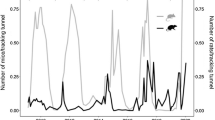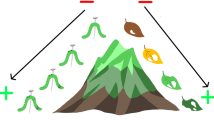Abstract
Herbivore overabundance and species invasions could alter decomposition rates in temperate forests, with consequent effects on carbon sequestration, nutrient retention, and other ecosystem processes. At local scales, herbivores, invasive plants, and soil macroinvertebrates can be important drivers of decomposition, but interactive effects among these different groups are unknown. We tested for the effects of white-tailed deer, Amur honeysuckle, and earthworm activity (manipulated via mesh exclusion) on litter decomposition rates and loss of litter nitrogen (N) in five hardwood forest sites in southwestern Ohio. Each site consisted of a 20 × 20-m deer exclosure paired with a deer access plot; honeysuckle was removed from half of each plot. Effects of earthworm activity were tested using paired litter boxes of fine mesh (0.25 mm; earthworms excluded) or coarse mesh (10 mm; earthworm access). Restriction of earthworm activity in fine mesh treatments slowed litter decomposition and increased retention of N in the litter layer compared to coarse mesh. Deer access interacted with mesh treatments, with faster decomposition occurring in deer access, coarse mesh treatments relative to others. Greater earthworm biomass in deer access plots relative to deer exclosure plots corresponded with more rapid litter decomposition. Honeysuckle presence did not affect litter decomposition, but did increase litter N retention. The interactions between deer and earthworm activity indicate that reductions in deer populations may slow litter decomposition rates, increasing complexity of habitat structure at the soil surface, which relates to habitat for plants and animals.





Similar content being viewed by others
References
Aerts R. 1997. Climate, leaf litter chemistry and leaf litter decomposition in terrestrial ecosystems: a triangular relationship. Oikos 79:439–49.
Arthur MA, Bray SR, Kuchle CR, McEwan RW. 2012. The influence of the invasive shrub, Lonicera maackii, on leaf decomposition and microbial community dynamics. Plant Ecol 213:1571–82.
Averill KM, Mortensen DA, Smithwick EAH, Kalisz S, McShea WJ, Bourg NA, Parker JD, Royo AA, Abrams MD, Apsley DK, Blossey B, Boucher DH, Caraher KL, DiTommaso A, Johnson SE, Masson R, Nuzzo VA. 2018. A regional assessment of white-tailed deer effects on plant invasion. AoB Plants 10:plx047.
Ayres E, Steltzer H, Simmons BL, Simpson RT, Steinweg JM, Wallenstein MD, Mellor N, Parton WJ, Moore JC, Wall DH. 2009. Home-field advantage accelerates leaf litter decomposition in forests. Soil Biol Biochem 41:606–10.
Bates D, Maechler M, Bolker B, Walker S. 2015. Fitting linear mixed-effects models using lme4. J Stat Softw 67:1–48.
Belote RT, Jones RH. 2009. Tree leaf litter composition and nonnative earthworms influence plant invasion in experimental forest floor mesocosms. Biol Invasions 11:1045–52.
Blair BC, Stowasser A. 2009. Impact of Lonicera maackii on decomposition rates of native leaf litter in a southwestern Ohio Woodland. Ohio J Sci 109:43–8.
Bohlen PJ, Groffman PM, Fahey TJ, Fisk MC, Suarez E, Pelletier DM, Fahey RT. 2004a. Ecosystem consequences of exotic earthworm invasion of north temperate forests. Ecosystems 7:1–12.
Bohlen PJ, Scheu S, Hale CM, McLean MA, Migge S, Groffman PM, Parkinson D. 2004b. Non-native invasive earthworms as agents of change in northern temperate forests. Front Ecol Environ 2:427–35.
Bressette JW, Beck H, Beauchamp VB. 2012. Beyond the browse line: complex cascade effects mediated by white-tailed deer. Oikos 121:1749–60.
Chang CH, Szlavecz K, Buyer JS. 2016. Species-specific effects of earthworms on microbial communities and the fate of litter-derived carbon. Soil Biol Biochem 100:129–39.
Chapin FSIII, Matson PA, Mooney HA. 2011. Principles of terrestrial ecosystem ecology. New York: Springer.
Côté S, Rooney T, Tremblay J. 2004. Ecological impacts of deer overabundance. Annu Rev Ecol Evol Syst 35:113–47.
Dávalos A, Simpson E, Nuzzo V, Blossey B. 2015. Non-consumptive effects of native deer on introduced earthworm abundance. Ecosystems 18:1029–42.
Fahey TJ, Yavitt JB, Sherman RE, Maerz JC, Groffman PM, Fisk MC, Bohlen PJ. 2013a. Earthworm effects on the incorporation of litter C and N into soil organic matter in a sugar maple forest. Ecol Appl 23:1185–201.
Fahey TJ, Yavitt JB, Sherman RE, Maerz JC, Groffman PM, Fisk MC, Bohlen PJ. 2013b. Earthworms, litter and soil carbon in a northern hardwood forest. Biogeochemistry 114:269–80.
Ferlian O, Eisenhauer N, Aguirrebengoa M, Camara M, Ramirez-Rojas I, Santos F, Tanalgo K, Thakur MP. 2018. Invasive earthworms erode soil biodiversity: a meta-analysis. J Anim Ecol 87:162–72.
Fox J, Weisberg S. 2011. An R companion to applied regressions. 2nd edn. Thousand Oaks: Sage.
Frelich LE, Hale CM, Scheu S, Holdsworth AR, Heneghan L, Bohlen PJ, Reich PB. 2006. Earthworm invasion into previously earthworm-free temperate and boreal forests. Biol Invasions 8:1235–45.
Hale CM, Frelich LE, Reich PB, Pastor J. 2005. Effects of European earthworm invasion on soil characteristics in northern hardwood forests of Minnesota, USA. Ecosystems 8:911–27.
Harrison K, Bardgett RD. 2008. Impacts of grazing and browsing by large herbivores on soils and soil biological properties. In: Gordon IJ, Prins HHT, Eds. The ecology of browsing and grazing. New York: Springer. p 201–16.
Hendrix PF, Callaham MA, Lachnicht SL, Blair JM, James SW, Zhou X. 1999. Stable isotopic studies of resource utilization by nearctic earthworms (Diplocardia, Oligochaeta) in subtropical savanna and forest ecosystems. Pedobiologia 43:818–23.
Heneghan L, Steffen J, Fagen K. 2007. Interactions of an introduced shrub and introduced earthworms in an Illinois urban woodland: impact on leaf litter decomposition. Pedobiologia 50:543–51.
Holdsworth AR, Frelich LE, Reich PB. 2008. Litter decomposition in earthworm-invaded northern hardwood forests: role of invasion degree and litter chemistry. Ecoscience 15:536–44.
Lawrence AP, Bowers MA. 2002. A test of the ‘hot’ mustard extraction method of sampling earthworms. Soil Biol Biochem 34:549–52.
Lefcheck JS. 2016. piecewiseSEM: piecewise structural equation modeling in R for ecology, evolution, and systematics. Methods Ecol Evol 7:573–9.
Lenth R. 2018. emmeans: estimated marginal means, aka least-squares means. R package version 1.4.2.
Lloyd G, Mahon MB, Crist TO. 2019. Invasive shrub cover and tree species composition influence exotic earthworms. For Ecol Manag 447:53–9.
Madritch MD, Lindroth RL. 2009. Removal of invasive shrubs reduces exotic earthworm populations. Biol Invasions 11:663–71.
Mahon MB, Campbell KU, Crist TO. 2019. Experimental effects of white-tailed deer and an invasive shrub on forest ant communities. Oecologia 191:633–44.
Mahon MB, Crist TO. 2019. Invasive earthworm and soil litter response to the experimental removal of white-tailed deer and an invasive shrub. Ecology 100:e02688.
McGuire KL, Treseder KK. 2010. Microbial communities and their relevance for ecosystem models: decomposition as a case study. Soil Biol Biochem 42:529–35.
McNeish RE, McEwan RW. 2016. A review on the invasion ecology of Amur honeysuckle (Lonicera maackii, Caprifoliaceae) a case study of ecological impacts at multiple scales. J Torrey Bot Soc 143:367–85.
Medley KE, Krisko B. 2007. Physical site conditions and land use history as factors influencing the conservation of regrowth forests in a southwest Ohio nature reserve. Natural Areas J 27:31–40.
Oksanen J, Blanchet FG, Friendly M, Kindt R, Legendre P, McGlinn D, Minchin PR, O’Hara RB, Simpson GL, Solymos P, Stevens MHH, Szoeks E, Wagner H. 2018. vegan: Community Ecology Package. R package version 2.5.
Olson JS. 1963. Energy storage and the balance of producers and decomposers in ecological systems. Ecology 44:322.
Peebles-Spencer JR, Gorchov DL, Crist TO. 2017. Effects of an invasive shrub, Lonicera maackii, and a generalist herbivore, white-tailed deer, on forest floor plant community composition. For Ecol Manag 402:204–12.
Petersen H, Luxton M. 1982. A comparative analysis of soil fauna populations and their role in decomposition processes. Oikos 39:288–388.
Peterson TE. 2018. Factors affecting densities of white-tailed deer (Odocoileus virginianus) in eastern deciduous forest: the roles of and surrounding land use, forest habitat edge, and invasive shrubs. Oxford: Thesis, Miami University.
Pinheiro JC, Bates DM. 2000. Mixed-effects models in S and S-PLUS. New York: Springer.
Pipal RP. 2014. Earthworm, microbial biomass, and leaf litter decay responses after invasive honeysuckle shrub removal from urban woodlands. Louisville: Thesis, University of Louisville.
Poulette MM, Arthur MA. 2012. The impact of the invasive shrub Lonicera maackii on the decomposition dynamics of a native plant community. Ecol Appl 22:412–24.
R Development Core Team. 2018. R: a language and environment for statistical computing. Vienna: R Foundation for Statistical Computing. http://www.R-project.org/. Accessed 1 May 2018.
Rooney TP. 2009. High white-tailed deer densities benefit graminoids and contribute to biotic homogenization of forest ground-layer vegetation. Plant Ecol 202:103–11.
Rooney TP, Waller DM. 2003. Direct and indirect effects of white-tailed deer in forest ecosystems. For Ecol Manag 181:165–76.
Rovira P, Rovira R. 2010. Fitting litter decomposition datasets to mathematical curves: towards a generalised exponential approach. Geoderma 155:329–43.
Suárez ER, Fahey TJ, Yavitt JB, Groffman PM, Bohlen PJ. 2006. Patterns of litter disappearance in a northern hardwood forest invaded by exotic earthworms. Ecol Appl 16:154–65.
Trammell TLE, Ralston HA, Scroggins SA, Carreiro MM. 2012. Foliar production and decomposition rates in urban forests invaded by the exotic invasive shrub, Lonicera maackii. Biol Invasions 14:529–45.
Vilà M, Espinar JL, Hejda M, Hulme PE, Jarošík V, Maron JL, Pergl J, Schaffner U, Sun Y, Pyšek P. 2011. Ecological impacts of invasive alien plants: a meta-analysis of their effects on species, communities and ecosystems. Ecol Lett 14:702–8.
Wagg C, Bender SF, Widmer F, van der Heijden MGA. 2014. Soil biodiversity and soil community composition determine ecosystem multifunctionality. Proc Natl Acad Sci USA 111:5266–70.
Wardle DA, Bardgett RD, Klironomosw JN, Setala H, van der Putten WH, Wall DH. 2004. Ecological linkages between aboveground and belowground biota. Science 304:1629–33.
Wardle DA, Bonner KI, Barker GM. 2002. Linkages between plant litter decomposition, litter quality, and vegetation responses to herbivores. Funct Ecol 16:585–95.
Acknowledgements
We thank B King, T Meyers, T Peterson, K Crist, A VanGorder, K Donahue, and T Ratliff for providing assistance in both the field and laboratory throughout the study. We thank T Rooney, J Zhang, and D Gorchov for feedback on an early version of this manuscript. We are grateful to the Miami University Natural Areas and J Reid for maintaining deer exclosures and providing access to the study locations.
Funding
This study was funded by Miami University.
Author information
Authors and Affiliations
Corresponding author
Ethics declarations
Conflict of interest
The authors declare they have no conflict of interest.
Electronic supplementary material
Below is the link to the electronic supplementary material.
Rights and permissions
About this article
Cite this article
Mahon, M.B., Fisk, M.C. & Crist, T.O. Interactive Effects of White-Tailed Deer, an Invasive Shrub, and Exotic Earthworms on Leaf Litter Decomposition. Ecosystems 23, 1523–1535 (2020). https://doi.org/10.1007/s10021-020-00485-9
Received:
Accepted:
Published:
Issue Date:
DOI: https://doi.org/10.1007/s10021-020-00485-9




